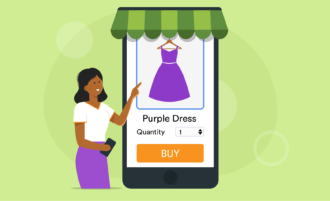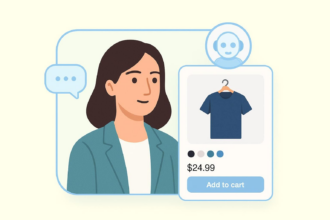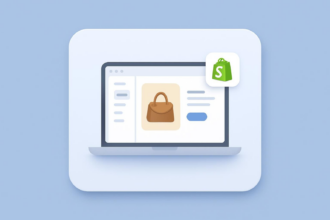Dropshipping best practices
- Work with the supplier to fix customer issues
- Opt for flexibility
- Keep an eye on inventory
- Offer customer support
- Improve shipping offerings
- Have fraud prevention strategies in place
Manufacturing products, managing storage, optimizing inventory levels, and figuring out shipping and delivery logistics can be challenging for online business owners. Luckily, there’s a way to run a profitable and successful business on an Shopify without ever having to handle any of those tasks.
Dropshipping is a business fulfillment model where the merchant acts as the middleman. Shopify store owners can build e-commerce websites and partner with dropshippers to sell and deliver products to customers. Instead of manufacturing, storing, and shipping products, you as the Shopify merchant don’t actually own the inventory — you just facilitate selling it through your online store.
Pro Tip
Shopify AI Agents can guide shoppers with personalized product recommendations based on store catalog data.
“A reputable and reliable dropshipping fulfillment process can literally make or break your business,” says Kurt Ellis, president of GLF E-Commerce Fulfillment. In this article, we cover how to dropship on Shopify, which partners to consider, and best practices to follow.
How to dropship on Shopify with partners
Some dropshippers work exclusively with Shopify merchants, while others work with various e-commerce platforms. According to Ellis, one of the most important things to look for in a dropshipping partner is their level of automation. Automation works for everything from picking and packing orders to shipping, so Shopify merchants — and their customers — don’t need to wait for someone to complete processes manually.
Dan Doughty, founder of Dripshipper, says it’s also vital to consider the physical distance between potential suppliers and your customers. “If you’re selling to American customers but your dropshipper is based in a country far away, such as China, the customer is going to experience very long delivery times,” says Doughty. “The closer your supplier is to the customer, the shorter the transit time, and the happier your customer will be.”
If you’re considering the dropshipping business model, here are some major dropshipping players you may want to work with.
- AliExpress: You can access more than 100 million products on AliExpress, the majority of which are manufactured or sourced by businesses in China. The company dropships to hundreds of countries around the world, and many Shopify merchants use it.
- Alibaba: If you run a B2B or wholesale business, you’ll find what you need through Alibaba. It carries almost 6,000 categories of products and can also customize products for retail. Keep in mind that shipping with Alibaba can take six weeks or more.
- Oberlo: Created exclusively for Shopify, Oberlo is an app you can use to import products from AliExpress to the Shopify store. In addition to sourcing products from AliExpress, Oberlo also has its own supplier network, which Shopify businesses can use to find products their customers will love.
- SaleHoo: This company has a large supplier directory and serves the American, British, and Australian markets. SaleHoo sources inventory from AliExpress and vets suppliers in a number of categories.
- Worldwide Brands: A well-established dropshipper, Worldwide Brands’ suppliers have to meet a specific set of standards in order to be included in the directory. They offer wholesale products in a number of categories, such as pet supplies, jewelry, apparel, and more.
Dropshipping best practices
Want to make sure dropshipping is successful for you and your customers? Take note of these tips.
- Work with the supplier to fix customer issues. Issues like shipping delays and damaged products are bound to happen from time to time. Have an agreement in place with your supplier on how to resolve such issues, and be sure to make things right with the customer. This may mean shipping out a new product free of charge or offering a refund.
- Opt for flexibility. Ellis suggests looking for a dropshipping fulfillment partner that’s familiar with the ups and downs and seasonal shifts of your online business. This way, they can help with any spikes in sales promotions or other fluctuations throughout the year.
- Keep an eye on inventory. While you don’t need to manage inventory as closely as if you were storing and shipping your own products, you do need to be aware of supplier shortages. Some Shopify merchants work with multiple suppliers for the same products to avoid any out-of-stock scenarios.
- Offer customer support. Your customers don’t know you’re dropshipping, and many don’t care. They do, however, want to be able to speak with a representative when they have questions about a certain product or shipping timelines.
It’s also important to offer the highest-quality products possible. “If you have poor-quality products, you’re going to have a higher return rate,” says Doughty.
- Improve shipping offerings. Customers can afford to be selective with their purchases because shipping deals are highly competitive, notes Ellis. Consider shipping to international locations and expediting delivery times where possible. Look for dropshippers that can reduce shipping costs and packing materials.
- Have fraud prevention strategies in place. To reduce fraudulent orders, consider using address verification systems that can flag instances of multiple names attached to a single shipping address or spam email addresses.
If you want to run a successful business but don’t want to manage products, inventory, shipping, and delivery, dropshipping can be a great option for you. Check out the partners available for your industry and be sure to follow the best practices for how to dropship on Shopify.





























Send Comment: